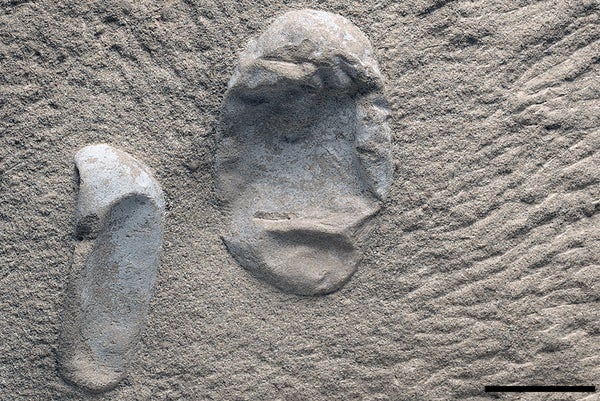Thanks in part to an abundance of fossil discoveries in recent decades, scientists now recognize more than 200 species of pterosaur—the winged reptiles that dominated the world’s skies for 160 million years. But almost nothing is known about how they bred or how their young developed. As recently as 2014 the available scientific evidence on those topics added up to a grand total of just three pterosaur eggs, all badly flattened.
That dramatically changes with the description in this week’s Science of a sandstone block containing at least 215 fossilized eggs of a Cretaceous era pterosaur, Hamipterus tianshanensis. Many are preserved in three dimensions, and at least 16 contain partial embryonic remains.
A research team led by Xiaolin Wang of the Institute of Vertebrate Paleontology and Paleoanthropology (IVPP) in Beijing discovered the eggs, embedded in a rock slab more than three square meters in area, at a dig in northwestern China. Analysis of sediments in the find suggests “that events of high energy such as storms passed over a nesting site” by an ancient lake, the co-authors write, causing the egg mass to float “for a short period of time, becoming concentrated and eventually buried.”
On supporting science journalism
If you're enjoying this article, consider supporting our award-winning journalism by subscribing. By purchasing a subscription you are helping to ensure the future of impactful stories about the discoveries and ideas shaping our world today.
Preservation of any pterosaur fossil is exceptional, partly because their bones were so thin. Extreme scarcity is even more the case for fossilized remains of their soft, pliable eggs, leading pterosaur experts not involved in the new find to call it “a pretty amazing fossil,” and “just phenomenal.” It’s “one of the most extraordinary aggregations of fossils I’ve seen,” says pterosaur specialist David Unwin of the University of Leicester. “What really impresses me is that it captures almost an entire life history: eggs, hatchlings, juveniles, sub-adults and adults. Just to assemble that kind of evidence for any kind of vertebrate species is very difficult and very rare, and that you have it all on a contiguous piece of rock is impressive.”
The eggs in the slab are torn and filled with sandstone—but that helped preserve them three-dimensionally. According to co-author Shunxing Jiang, also of the IVPP, the slab represents only a partial excavation of a field site where researchers can see eight layers of pterosaur bones, four of them including eggs. Those layers indicate that pterosaurs of this species returned to the same nesting site over long periods of time.
Other tantalizing behavioral clues also show up in the slab. “The large number of eggs indicates that they belonged to several clutches and were laid by different females,” the co-authors write, implying that Hamipterus probably nested in colonies. Contrary to the popular image of pterosaurs as solitary predators, they add, “gregarious behavior might have been widespread”—at least among species that occurred, like Hamipterus, relatively late in the long evolutionary history of pterosaurs.
The co-authors also make the controversial argument that pterosaurs may have been unable to fly as hatchlings and “probably needed some parental care.” They base that argument on examination of the bones of individual embryos in the new find, using computed tomography scanning and other methods. This indicated that the forelimbs of individuals identified as near hatching were less developed than their hind limbs. In particular, “the humerus is very different from the humerus we see in adults” and lacks attachment points for the most important wing muscles, says co-author Taissa Rodrigues of Brazil’s Federal University of Espírito Santo. If hatchlings could not fly, they would have been unable to feed themselves. “So perhaps they were not very precocious,” Rodrigues says.
Other researchers question that argument. “I think they have fundamentally misinterpreted that,” Unwin says. The individuals the co-authors identify as near hatching were “probably mid-term, not ready to hatch by any stretch of the imagination,” based on their lack of teeth and “relatively poor level of ossification,” Unwin adds. The co-authors would have done better, he says, to focus on evidence in the slab about the early development of the pterosaur embryos: “Until recently we would have said we’re never going to have that kind of evidence, and now, wow, we have it.”
Michael Habib, an expert in biomechanics at the University of Southern California, thinks the co-authors were “probably correct” to argue that the pterosaur hatchlings were unable to fly. But he adds, “there is a difference between being developmentally less mature and being mechanically less robust.” That is, hatchling pterosaurs might well have had less-developed forelimbs than hind limbs—but they might still have been able to fly, given their low body weight. “The question is whether they have wings that can withstand the mechanical load of flight,” Habib says, adding that the co-authors “haven’t done that calculation yet.”
Regardless of such arguments about interpretation, Habib says, “this is a phenomenal specimen, and it’s going to be a gold mine of information about nest structure and development in pterosaurs.”
